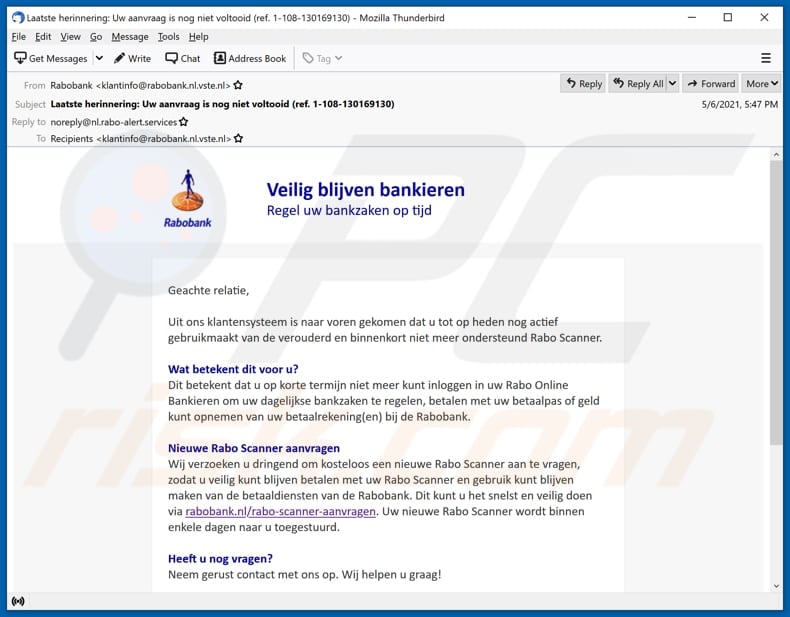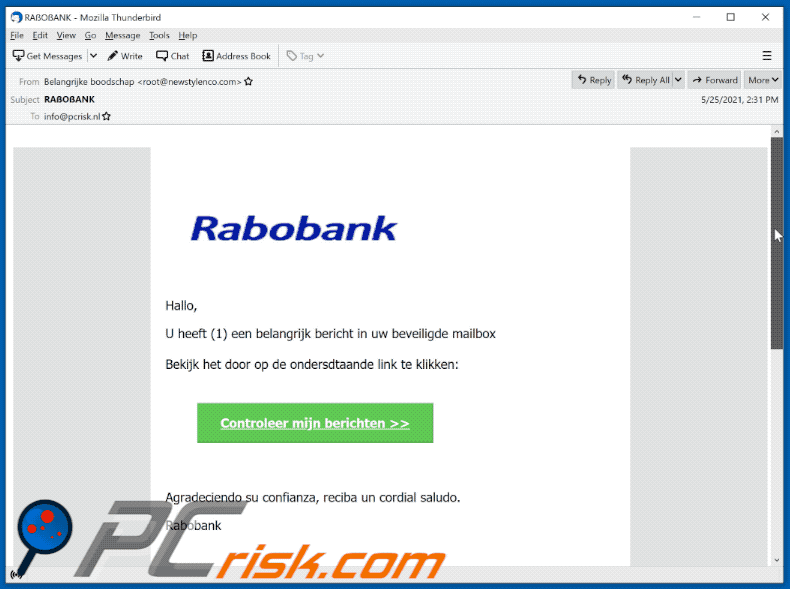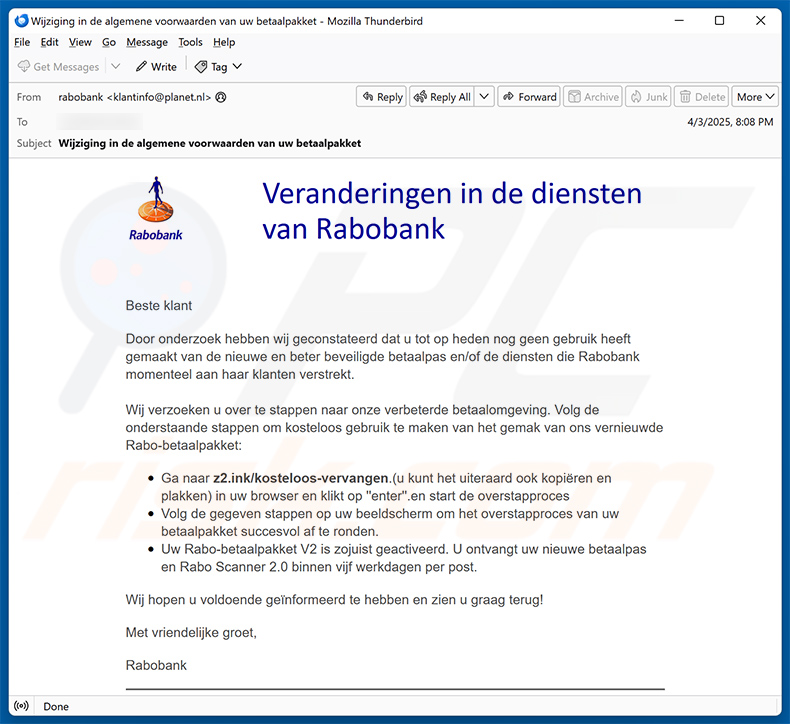Get free scan and check if your device is infected.
Remove it nowTo use full-featured product, you have to purchase a license for Combo Cleaner. Seven days free trial available. Combo Cleaner is owned and operated by RCS LT, the parent company of PCRisk.com.
What is "Rabobank email scam"?
It is common that scammers send fraudulent emails to trick recipients into providing sensitive information (for example, credit card details, login credentials, social security numbers), transferring money. Typically, they pretend to be legitimate companies (for example, banks, couriers, telecommunications, and internet service providers) to give legitimacy to their emails.
Scammers behind this scam pretend to be Rabobank, a Dutch multinational banking and financial services company. It is likely that the purpose of this scam campaign is to trick recipients into providing login credentials for Rabobank account.

"Rabobank" email scam overview
Scammers behind this scam claim that a recipient uses an outdated and soon no longer supported Rabo Scanner. They also claim that without the new scanner, it will be impossible to log into the Rabobank online banking account, make transactions using the debit card, withdraw money or use the account for any other daily banking activities.
Scammers urge a recipient to make a request for a new Rabo Scanner so that he or she could continue using Rabobank payment services. This email has a website link. It is likely that scammers use it to trick a recipient into entering Rabobank login credentials such as the account number, card number, PIN, login code.
It is important to know that scammers are likely to use stolen banking-related login credentials to make fraudulent purchases and transactions. It is also common that cybercriminals sell stolen sensitive information to third parties (other cybercriminals).
It is noteworthy that when scammers manage to steal login credentials for email, social media or other accounts, they try to use them to log into other accounts. Since there are people who use the same login credentials for multiple accounts, cybercriminals have more chances to hijack those other accounts too.
| Name | Rabobank Email Scam |
| Threat Type | Phishing, Scam, Social Engineering, Fraud |
| Fake Claim | Recipient uses an outdated Rabo Scanner |
| Disguise | Letter from Rabobank |
| Symptoms | Unauthorized online purchases, changed online account passwords, identity theft, illegal access of the computer. |
| Distribution methods | Deceptive emails, rogue online pop-up ads, search engine poisoning techniques, misspelled domains. |
| Damage | Loss of sensitive private information, monetary loss, identity theft. |
| Malware Removal (Windows) |
To eliminate possible malware infections, scan your computer with legitimate antivirus software. Our security researchers recommend using Combo Cleaner. Download Combo CleanerTo use full-featured product, you have to purchase a license for Combo Cleaner. 7 days free trial available. Combo Cleaner is owned and operated by RCS LT, the parent company of PCRisk.com. |
Spam campaigns in general
In conclusion, recipients who fall for scams like this lose access to their accounts, suffer monetary loss, become victims of identity theft, encounter problems related to online privacy, and other issues. Therefore, it is strongly recommended to carefully analyze received emails asking to log into personal accounts or provide sensitive information.
More examples of similar scams are "EuroLine Windows Exchange", "Standard Bank Financial Consultancy (SBFC)", and "System Administrator Quota Update". It is important to know that email can be used as a channel to deliver malware via an attached file or website link.
How do spam campaigns infect computers?
Email used to deliver malware usually contains a malicious attachment or a download website for a malicious file. In one way or another, the main purpose of such email is to trick a recipient into opening a malicious file designed to install malware on the operating system.
As a rule, cybercriminals behind such emails disguise them as important letters from legitimate companies, organizations, or other entities. A couple of examples of files that can be used to deliver malware via email are Microsoft Office, PDF documents, EXE and other executable files, JavaScript files, RAR, ZIP, or other archive files.
Malicious documents opened with Microsoft Office 2010 and newer versions do not install malware unless they are allowed to enable macros commands (editing/content). However, older MS Office versions do not have the "Protected View" mode.
Therefore, documents opened with older versions install malware without asking a user to enable macros (or editing, content).
How to avoid installation of malware?
Attachments (and website links) in received emails that are not relevant and are sent from an unknown, suspicious address should not be opened. It is very common that such emails are disguised as important, urgent letters from legitimate companies and contain malicious links, files.
Files and programs should be downloaded from official pages and through direct links. It is common that other sources for downloading files or programs are used to distribute malware.
Examples of sources that should not be used are third-party downloaders, unofficial websites, Peer-to-Peer networks (like torrent clients, eMule), free file hosting pages. Unofficial, fake software updating or activation tools should not be trusted too.
In most cases, those tools do not update or activate any installed software. They are designed by cybercriminals and used to distribute malicious software.
Moreover, it is not legal to activate licensed software with unofficial ('cracking') tools. Installed software has to be updated and activated with implemented functions or tools created by the official developers.
Additionally, it is recommended to run virus scans on a regular basis. They should be performed using a reputable antivirus or anti-spyware software.
If you've already opened malicious attachments, we recommend running a scan with Combo Cleaner Antivirus for Windows to automatically eliminate infiltrated malware.
Text presented in the Rabobank email scam:
Subject: Laatste herinnering: Uw aanvraag is nog niet voltooid (ref. 1-108-130169130)
Rabobank
Veilig blijven bankieren
Regel uw bankzaken op tijd
Geachte relatie,
Uit ons klantensysteem is naar voren gekomen dat u tot op heden nog actief gebruikmaakt van de verouderd en binnenkort niet meer ondersteund Rabo Scanner.
Wat betekent dit voor u?
Dit betekent dat u op korte termijn niet meer kunt inloggen in uw Rabo Online Bankieren om uw dagelijkse bankzaken te regelen, betalen met uw betaalpas of geld kunt opnemen van uw betaalrekening(en) bij de Rabobank.Nieuwe Rabo Scanner aanvragen
Wij verzoeken u dringend om kosteloos een nieuwe Rabo Scanner aan te vragen, zodat u veilig kunt blijven betalen met uw Rabo Scanner en gebruik kunt blijven maken van de betaaldiensten van de Rabobank. Dit kunt u het snelst en veilig doen via rabobank.nl/rabo-scanner-aanvragen. Uw nieuwe Rabo Scanner wordt binnen enkele dagen naar u toegestuurd.Heeft u nog vragen?
Neem gerust contact met ons op. Wij helpen u graag!Alvast hartelijk dank voor uw medewerking.
Met vriendelijke groet,
Rabobank
Youtube LinkedIn Facebook Instagram Twitter Rabobank
Other examples of Rabobank-themed spam emails used to promote a phishing website:
Sample 1:

Text presented within:
Subject: RAẞOẞANK
Hallo,
U heeft (1) een belangrijk bericht in uw beveiligde mailbox
Bekijk het door op de ondersdtaande link te klikken:
Controleer mijn berichten >>
Agradeciendo su confianza, reciba un cordial saludo.Rabobank
Dit bericht is automatisch verzonden, reageer er niet op.
Rabobankois een financiëleoinstellingointernationale deobancassuranco d'origineoneerlandaise, opgericht in 1972 door de fusie van de banken Coöperatieve Centrale Raiffeisen-Bank en Coöperatieve Centrale Boerenleenbank. De par een structuur, c'est une coopérative
Vos commandes | Votre compte | Amazon.fr
Sample 2:

Text presented within:
Subject: Laatste waarschuwing! Vervang uw Rabo Scanner!
RabobankGeachte heer/mevrouw,
Uw huidige Rabo Scanner voldoet niet meer aan de standaard eisen van de Rabobank en komt hierdoor binnenkort te vervallen.
We adviseren u om uw nieuwe Rabo Scanner binnen 2 werkdagen op te vragen om een blokkade te voorkomen.Is uw scanner al geblokkeerd?
Dan kunt u in de tussentijd niet inloggen of betalen.
Kosten nieuwe scanner
Om uw nieuwe Rabo Scanner geheel kosteloos te ontvangen heeft u uiterst 2 dagen de tijd om de aanvraag in te dienen.
Dit kunt u doen door hier te klikken.
Na de genoemde datum brengen we 24,95 euro in rekening per Rabo Scanner.Uw mening
Wat kunnen wij volgens u verbeteren? Geef hier uw mening.
Heeft u nog vragen? Neem gerust contact met ons op.Met vriendelijke groet,
Afdeling bankzaken
Rabobank
Sample 3:

Text presented within:
Subject: Wijziging in de algemene voorwaarden van uw betaalpakket
Rabobank
Veranderingen in de diensten van Rabobank
Beste klant
Door onderzoek hebben wij geconstateerd dat u tot op heden nog geen gebruik heeft gemaakt van de nieuwe en beter beveiligde betaalpas en/of de diensten die Rabobank momenteel aan haar klanten verstrekt.
Wij verzoeken u over te stappen naar onze verbeterde betaalomgeving. Volg de onderstaande stappen om kosteloos gebruik te maken van het gemak van ons vernieuwde Rabo-betaalpakket:
Ga naar z2.ink/kosteloos-vervangen.(u kunt het uiteraard ook kopiëren en plakken) in uw browser en klikt op ''enter''.en start de overstapproces olg de gegeven stappen op uw beeldscherm om het overstapproces van uw betaalpakket succesvol af te ronden.
Uw Rabo-betaalpakket V2 is zojuist geactiveerd. U ontvangt uw nieuwe betaalpas en Rabo Scanner 2.0 binnen vijf werkdagen per post.Wij hopen u voldoende geïnformeerd te hebben en zien u graag terug!
Met vriendelijke groet,
Rabobank
Instant automatic malware removal:
Manual threat removal might be a lengthy and complicated process that requires advanced IT skills. Combo Cleaner is a professional automatic malware removal tool that is recommended to get rid of malware. Download it by clicking the button below:
DOWNLOAD Combo CleanerBy downloading any software listed on this website you agree to our Privacy Policy and Terms of Use. To use full-featured product, you have to purchase a license for Combo Cleaner. 7 days free trial available. Combo Cleaner is owned and operated by RCS LT, the parent company of PCRisk.com.
Quick menu:
- What is Rabobank spam?
- Types of malicious emails.
- How to spot a malicious email?
- What to do if you fell for an email scam?
Types of malicious emails:
![]() Phishing Emails
Phishing Emails
Most commonly, cybercriminals use deceptive emails to trick Internet users into giving away their sensitive private information, for example, login information for various online services, email accounts, or online banking information.
Such attacks are called phishing. In a phishing attack, cybercriminals usually send an email message with some popular service logo (for example, Microsoft, DHL, Amazon, Netflix), create urgency (wrong shipping address, expired password, etc.), and place a link which they hope their potential victims will click on.
After clicking the link presented in such email message, victims are redirected to a fake website that looks identical or extremely similar to the original one. Victims are then asked to enter their password, credit card details, or some other information that gets stolen by cybercriminals.
![]() Emails with Malicious Attachments
Emails with Malicious Attachments
Another popular attack vector is email spam with malicious attachments that infect users' computers with malware. Malicious attachments usually carry trojans that are capable of stealing passwords, banking information, and other sensitive information.
In such attacks, cybercriminals' main goal is to trick their potential victims into opening an infected email attachment. To achieve this goal, email messages usually talk about recently received invoices, faxes, or voice messages.
If a potential victim falls for the lure and opens the attachment, their computers get infected, and cybercriminals can collect a lot of sensitive information.
While it's a more complicated method to steal personal information (spam filters and antivirus programs usually detect such attempts), if successful, cybercriminals can get a much wider array of data and can collect information for a long period of time.
![]() Sextortion Emails
Sextortion Emails
This is a type of phishing. In this case, users receive an email claiming that a cybercriminal could access the webcam of the potential victim and has a video recording of one's masturbation.
To get rid of the video, victims are asked to pay a ransom (usually using Bitcoin or another cryptocurrency). Nevertheless, all of these claims are false - users who receive such emails should ignore and delete them.
How to spot a malicious email?
While cyber criminals try to make their lure emails look trustworthy, here are some things that you should look for when trying to spot a phishing email:
- Check the sender's ("from") email address: Hover your mouse over the "from" address and check if it's legitimate. For example, if you received an email from Microsoft, be sure to check if the email address is @microsoft.com and not something suspicious like @m1crosoft.com, @microsfot.com, @account-security-noreply.com, etc.
- Check for generic greetings: If the greeting in the email is "Dear user", "Dear @youremail.com", "Dear valued customer", this should raise suspiciousness. Most commonly, companies call you by your name. Lack of this information could signal a phishing attempt.
- Check the links in the email: Hover your mouse over the link presented in the email, if the link that appears seems suspicious, don't click it. For example, if you received an email from Microsoft and the link in the email shows that it will go to firebasestorage.googleapis.com/v0... you shouldn't trust it. It's best not to click any links in the emails but to visit the company website that sent you the email in the first place.
- Don't blindly trust email attachments: Most commonly, legitimate companies will ask you to log in to their website and to view any documents there; if you received an email with an attachment, it's a good idea to scan it with an antivirus application. Infected email attachments are a common attack vector used by cybercriminals.
To minimise the risk of opening phishing and malicious emails we recommend using Combo Cleaner Antivirus for Windows.
Example of a spam email:

What to do if you fell for an email scam?
- If you clicked on a link in a phishing email and entered your password - be sure to change your password as soon as possible. Usually, cybercriminals collect stolen credentials and then sell them to other groups that use them for malicious purposes. If you change your password in a timely manner, there's a chance that criminals won't have enough time to do any damage.
- If you entered your credit card information - contact your bank as soon as possible and explain the situation. There's a good chance that you will need to cancel your compromised credit card and get a new one.
- If you see any signs of identity theft - you should immediately contact the Federal Trade Commission. This institution will collect information about your situation and create a personal recovery plan.
- If you opened a malicious attachment - your computer is probably infected, you should scan it with a reputable antivirus application. For this purpose, we recommend using Combo Cleaner Antivirus for Windows.
- Help other Internet users - report phishing emails to Anti-Phishing Working Group, FBI’s Internet Crime Complaint Center, National Fraud Information Center and U.S. Department of Justice.
Frequently Asked Questions (FAQ)
Why did I receive this email?
Spam emails are not personal; thousands of users receive identical (or incredibly similar) messages.
I have provided my personal information when tricked by a spam email, what should I do?
If you have provided your log-in credentials – immediately change the passwords of all possibly exposed accounts and inform their official support. However, if you have disclosed other private information (e.g., ID card details, passport photos/scans, credit card numbers, etc.) – contact relevant authorities without delay.
I have read a spam email but didn't open the attachment, is my computer infected?
Merely opening/reading an email is harmless. Devices are infected when malicious attachments or links are opened/clicked.
I have downloaded and opened a file attached to a spam email, is my computer infected?
Whether the system was infected might depend on the format of the opened file. Once opened, executables cause infections almost without fail. Some formats may need additional actions (e.g., enabling macros, clicking embedded content, etc.) to trigger malware infiltration processes.
Will Combo Cleaner remove malware infections present in email attachments?
Combo Cleaner is designed to scan systems and eliminate all manner of threats. It is capable of detecting and removing most of the known malware infections. Remember that since high-end malicious software usually hides deep within systems – running a full system scan is essential.
Share:

Tomas Meskauskas
Expert security researcher, professional malware analyst
I am passionate about computer security and technology. I have an experience of over 10 years working in various companies related to computer technical issue solving and Internet security. I have been working as an author and editor for pcrisk.com since 2010. Follow me on Twitter and LinkedIn to stay informed about the latest online security threats.
PCrisk security portal is brought by a company RCS LT.
Joined forces of security researchers help educate computer users about the latest online security threats. More information about the company RCS LT.
Our malware removal guides are free. However, if you want to support us you can send us a donation.
DonatePCrisk security portal is brought by a company RCS LT.
Joined forces of security researchers help educate computer users about the latest online security threats. More information about the company RCS LT.
Our malware removal guides are free. However, if you want to support us you can send us a donation.
Donate
▼ Show Discussion